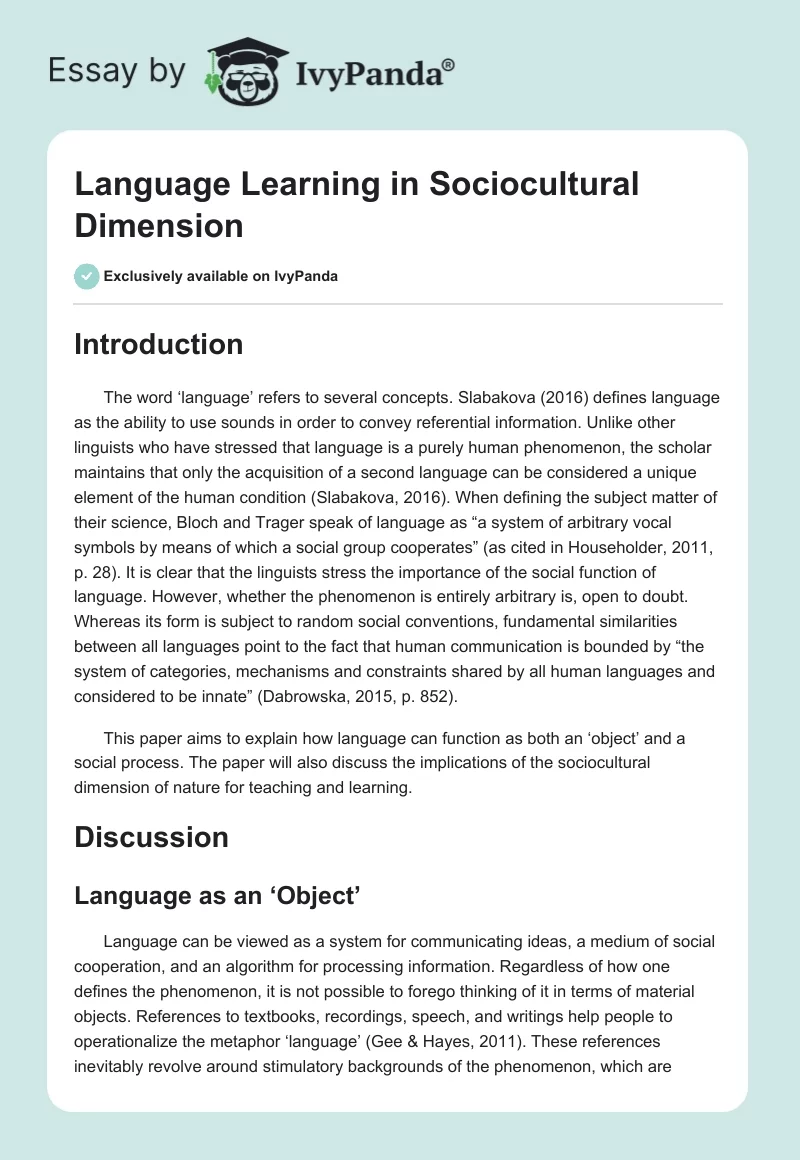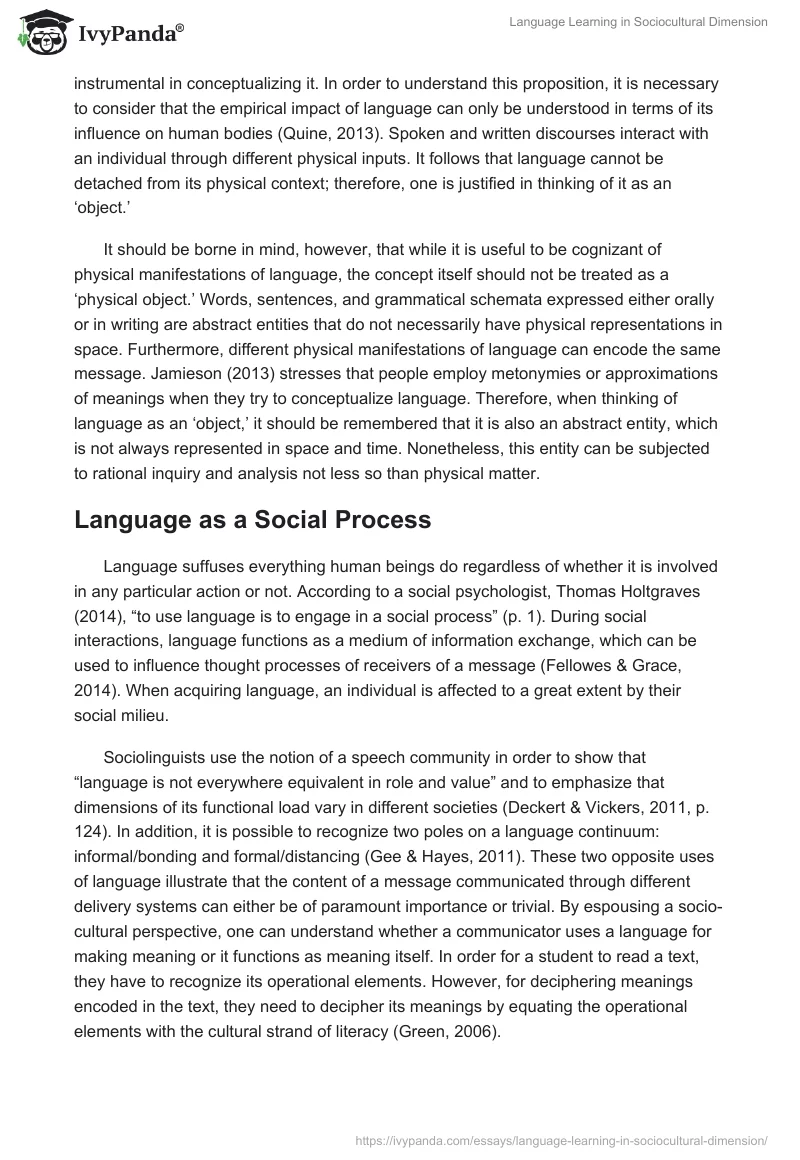Introduction
The word ‘language’ refers to several concepts. Slabakova (2016) defines language as the ability to use sounds in order to convey referential information. Unlike other linguists who have stressed that language is a purely human phenomenon, the scholar maintains that only the acquisition of a second language can be considered a unique element of the human condition (Slabakova, 2016). When defining the subject matter of their science, Bloch and Trager speak of language as “a system of arbitrary vocal symbols by means of which a social group cooperates” (as cited in Householder, 2011, p. 28). It is clear that the linguists stress the importance of the social function of language. However, whether the phenomenon is entirely arbitrary is, open to doubt. Whereas its form is subject to random social conventions, fundamental similarities between all languages point to the fact that human communication is bounded by “the system of categories, mechanisms and constraints shared by all human languages and considered to be innate” (Dabrowska, 2015, p. 852).
This paper aims to explain how language can function as both an ‘object’ and a social process. The paper will also discuss the implications of the sociocultural dimension of nature for teaching and learning.
Discussion
Language as an ‘Object’
Language can be viewed as a system for communicating ideas, a medium of social cooperation, and an algorithm for processing information. Regardless of how one defines the phenomenon, it is not possible to forego thinking of it in terms of material objects. References to textbooks, recordings, speech, and writings help people to operationalize the metaphor ‘language’ (Gee & Hayes, 2011). These references inevitably revolve around stimulatory backgrounds of the phenomenon, which are instrumental in conceptualizing it. In order to understand this proposition, it is necessary to consider that the empirical impact of language can only be understood in terms of its influence on human bodies (Quine, 2013). Spoken and written discourses interact with an individual through different physical inputs. It follows that language cannot be detached from its physical context; therefore, one is justified in thinking of it as an ‘object.’
It should be borne in mind, however, that while it is useful to be cognizant of physical manifestations of language, the concept itself should not be treated as a ‘physical object.’ Words, sentences, and grammatical schemata expressed either orally or in writing are abstract entities that do not necessarily have physical representations in space. Furthermore, different physical manifestations of language can encode the same message. Jamieson (2013) stresses that people employ metonymies or approximations of meanings when they try to conceptualize language. Therefore, when thinking of language as an ‘object,’ it should be remembered that it is also an abstract entity, which is not always represented in space and time. Nonetheless, this entity can be subjected to rational inquiry and analysis not less so than physical matter.
Language as a Social Process
Language suffuses everything human beings do regardless of whether it is involved in any particular action or not. According to a social psychologist, Thomas Holtgraves (2014), “to use language is to engage in a social process” (p. 1). During social interactions, language functions as a medium of information exchange, which can be used to influence thought processes of receivers of a message (Fellowes & Grace, 2014). When acquiring language, an individual is affected to a great extent by their social milieu.
Sociolinguists use the notion of a speech community in order to show that “language is not everywhere equivalent in role and value” and to emphasize that dimensions of its functional load vary in different societies (Deckert & Vickers, 2011, p. 124). In addition, it is possible to recognize two poles on a language continuum: informal/bonding and formal/distancing (Gee & Hayes, 2011). These two opposite uses of language illustrate that the content of a message communicated through different delivery systems can either be of paramount importance or trivial. By espousing a socio-cultural perspective, one can understand whether a communicator uses a language for making meaning or it functions as meaning itself. In order for a student to read a text, they have to recognize its operational elements. However, for deciphering meanings encoded in the text, they need to decipher its meanings by equating the operational elements with the cultural strand of literacy (Green, 2006).
The Sociocultural Dimension of Language in Teaching and Learning
Teachers of writing should be keenly aware of the socio-cultural dimension of language, in order to effectively contribute to healthy growth and development of young learners (Loane, 2016). It is essential to inform readers or code breakers that all language delivery systems can be used to promote certain ideologies. That is, views posited by writers can “act to empower some groups of people and marginalize others” (Green, 2006, p. 9). Therefore, teachers should encourage their students to adopt a critical stance toward all writings. It follows that learners should be cognizant of both writers and their own ideologies when either constructing or deconstructing a text.
Another example of how knowledge of the socio-cultural dimension of language can be applied in teaching is the promotion of culturally responsive pedagogy. This approach to instruction has emerged as a backlash against the standardization of student learning. However, if one were to explore the effects of the adherence to a mandated curriculum, they would discover that its impact on the narrowing of racial achievement is only marginal (Sleeter, 2012). Therefore, forward-looking educators should use their knowledge of the sociocultural nature of language for the promotion of cultural and linguistic diversity in their classrooms, thereby taking an ethics-based approach to education. By doing so, both teachers and their students will be able to oppose the oppressive notion that “students who are not able-bodied, heterosexual middle-class English-speaking adherents of European American culture primarily complicate educational processes and drain resources” (Shevalier & McKenzie, 2012, p. 1087).
Teachers who have a deep understanding of social and cultural facets of language can better control their instructional practices in order to benefit their students and build meaningful relationships with them. For example, by incorporating the sociocultural perspective into their professional practice, educators can gain social capital, which will make students more receptive to their instruction. Interactive teaching approaches such as cooperative learning can be used to “integrate students’ cultural and linguistic knowledge with basic reading skills” (Orosco & O’Connor, 2014, p. 518). Furthermore, the sociocultural language perspective is instrumental in helping teachers to understand their student’s learning styles. It has to do with the fact that culture provides the context of meaning (Emmitt, Zbaracki, Pollock, & Komesaroff, 2010). Therefore, educators should strive to learn more about different literate practices and cultures of their students.
Another example of the application of the sociocultural perspective is the facilitation of second language acquisition (SLA). Researchers in the field of SLA recognize that power relationships in a class can affect the process of language learning (Chapelle, 2013). Specifically, the extent to which a student is willing to speak or remain silent is directly proportional to the extent to which they perceive a relationship with their educator as equitable and productive (Chapelle, 2013). It follows that teachers should not disregard processes that shape their societies when developing environments in which learning takes place.
In addition to being aware of different languages that children bring into a classroom, an outstanding educator should be cognizant of diverse learners’ identities. Language acquisition requires a considerable amount of dedication. Therefore, teachers should encourage young learners to invest their time into a target language by appealing to their identities. A classroom should become a safe space in which students can construct their new language identities as well as discuss issues they face as members of diverse groups (Chapelle, 2013). The creation of pedagogical safe spaces will help young learners to overcome resistance to language acquisition. Educators who adopt the sociocultural perspective should remove structural constraints in a classroom, thereby helping their students to openly negotiate their new identities.
Conclusion
The paper has explained how language functions as both an ‘object’ and a social process. It has been argued that whereas physical and conceptual manifestations of language can be treated as ‘objects,’ its application in a societal context has to be regarded as a social process. The paper has outlined how an educator can adopt a sociocultural language perspective in order to better serve the educational needs of young learners.
References
Chapelle, C. (2013). The encyclopedia of applied linguistics (Vols. 1-10). Hoboken, NJ: Blackwell Publishing.
Dabrowska, E. (2015). What exactly is Universal Grammar, and has anyone seen it? Frontiers in Psychology, 6(1), 852-859.
Deckert, S., & Vickers, C. (2011). An introduction to sociolinguistics: Society and identity. London, England: A&C Black.
Emmitt, M., Zbaracki, M., Pollock, M., & Komesaroff, L. (2010). Language & learning: An introduction for teaching. New York, NY: Oxford University Press.
Fellowes, J., & Grace, O. (2014). Understanding oral language: Language, literacy and early childhood education (2nd ed.). New York, NY: Oxford University Press.
Gee, J., & Hayes, E. (2011). Language and learning in the digital age (1st ed.). Abington, England: Routledge.
Green, D. (2006). Understanding language and language learning. In R. Campbell (Ed.), Literacies and learners: Current perspectives (pp. 1-23). London, England: Pearson Education.
Holtgraves, T. (2014). The Oxford handbook of language and social psychology. New York, NY: Oxford University Press.
Householder, F. (2011). Linguistic speculations. Cambridge, England: Cambridge University Press.
Jamieson, D. (2013). Language, mind, and art: Essays in appreciation and analysis. New York, NY: Springer Science & Business.
Loane, G. (2016). Developing young writers in the classroom: I’ve got something to say. Abington, England: Routledge.
Orosco, M., & O’Connor, R. (2014). Culturally responsive instruction for English language learners with learning disabilities. Journal of Learning Disabilities, 47(6), 515-531.
Quine, W. (2013). Word and object. London, England: The MIT Press.
Shevalier, R., & McKenzie, B. (2012). Culturally responsive teaching as an ethics-and care-based approach to urban education. Urban Education, 47(6), 1086-1105.
Slabakova, R. (2016). Second language acquisition. New York, NY: Oxford University Press.
Sleeter, C. (2012). Confronting marginalization of culturally responsive pedagogy. Urban Education, 47(3), 562-584.


